Explore above and below the waves on this 14-day Flores itinerary in Indonesia, taking in the highlights of Komodo National Park, along with volcanoes, traditional villages, and some of the best off-the-beaten track beaches in Indonesia on the island of Flores.
I’ve been pretty much hooked on the idea of Flores since the 1990s when I first came across images of Kelimutu’s iridescent volcanic crater lakes in a guidebook. Having travelled extensively around Indonesia over the years, that it took me almost three decades to get to Flores will always be something of a mystery to me.
But I’ve never forgotten those first images, or the stories I heard from other travellers, of a mysterious land where dragons roam, volcanoes belch, and a turquoise ocean laps the shores of pristine, jungle-fringed beaches.
In the end, it wasn’t just the island’s wonders that finally convinced us to book tickets to Flores, but the allure of what waited offshore, in nature’s own underwater wonderland of Komodo National Park.
And while those undersea adventures still rate among the best diving experiences we’ve ever had, we were equally blown away by our overland journey through the emerald island of Flores, with its rich history and culture, and lush green landscape that could easily pass for a Jurassic Park film set.
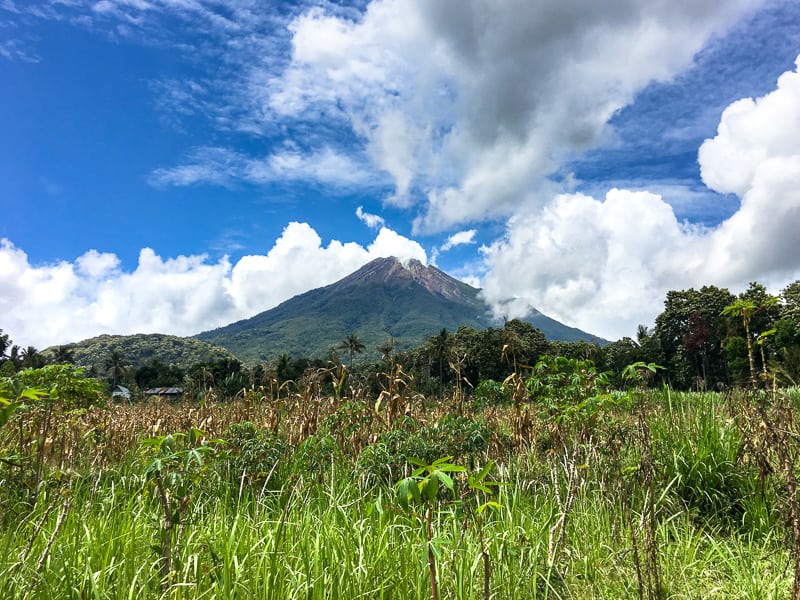
What’s in this post?
Our 14 Day Flores Itinerary
Days 1 & 2: Labuan Bajo
Days 3 – 7: Exploring Komodo National Park
Day 8: Labuan Bajo to Ruteng
Day 9: Ruteng to Bajawa
Day 10: Bajawa and the Surrounds
Day 11: Bajawa to Moni
Day 12: Around Moni / Kelimutu
Day 13: Koka Beach
Day 14: Final Morning & Farewell Flores
Planning a Flores Trip
How to get to Flores?
Flores Travel – How do I get around?
Hire a local driver-guide
Flores Weather: When is the Best Time to Visit?
This post contains affiliate links. If you choose to buy through these links we may earn a small commission at no extra cost to you, which helps us to keep Two for the World running. Many thanks for your support!
Our 14 Day Flores Itinerary
WEEK 1 – Islands, Dragons and Reefs
Days 1 & 2: Labuan Bajo, Flores
Overnight: Labuan Bajo (2 nights)
As we’d booked our Komodo diving trip in advance, we only spent a couple of days in Flores’ capital, Labuan Bajo, to get ourselves organised, meet our dive crew, and stock up on a few lastminute supplies.
I won’t lie, I’m not a real fan of Labuan Bajo. It’s a typical dusty, busy town in an otherwise stunning place, and for me, an opportunity seems to have been missed in the way it’s been developed.
That said, there’s a decent range of accommodation here, plenty of shops and restaurants, and ample places to book onward travel, snorkelling and dive trips, Komodo tours, and other excursions.
There’s also Paradise Bar, which turned out to be our favourite place in town. Don’t miss a sundowner at this chill joint up the hill, overlooking the sea and islands. As we discovered, one visit isn’t enough.
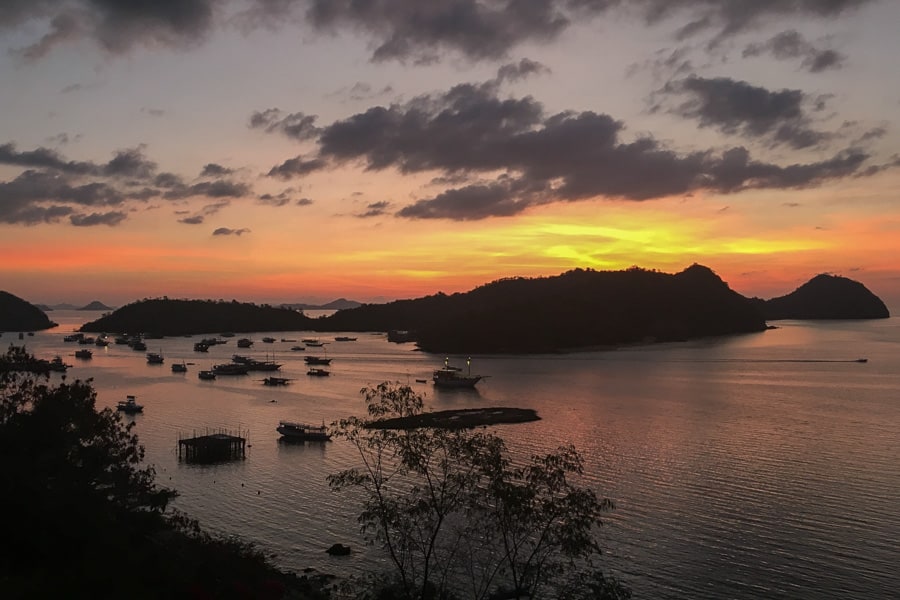
Where to Stay in Labuan Bajo
As the primary arrival and departure point for Flores, Labuian Bajo has a decent range of accommodation options. We split our stay here between a hotel in the centre of town and another up in the hills outside of town.
The downtown Green Hill Boutique Hotel has a wide range of room types but can get noisy, so bring earplugs if you stay here. Our room was basic and clean, staff were friendly, and the hotel was centrally located, allowing us to easily sort stuff out ahead of boat and road trips. The awesome coffee at Café In Hit at the entrance made it even better.
Golo Hilltop Hotel was a lovely escape overlooking the ocean. You need a ride into town from here, but we were happy to while away our short stay as a captive audience on site. Our simple tiled room was clean and comfortable, the small pool was a welcome retreat from the heat, and the views were fantastic.
Other options that get consistently good reviews include:
- Good value: Puu Pau Hotel & Coffee Shop– central | clean comfy rooms | modern | friendly staff
- Mid-range: Seaesta Komodo Hostel & Hotel – comfy rooms | rooftop pool and sundeck | bar and restaurant | nightly DJs
- Indulge: Elang Hillside Bamboo Villas – ocean views | peaceful | pool | close to airport
Noise in Labuan Bajo: Staying centrally in Labuan Bajo is super convenient but can be noisy, some hotels will supply earplugs, but it’s always good to bring your own just in case (or stay outside town if you are sensitive to noise).
Days 3 – 7: Exploring Komodo National Park
Overnight: Liveaboard Boat (4 nights) + Labuan Bajo (1 night)
While Flores may be one of Indonesia’s more low-key tourist destinations, its renowned reptiles and top-class diving draw visitors from around the world.
Komodo Dragons live on five islands in the archipelago, including in a remote part of Flores, but they can only be visited as part of a Komodo tour to the islands of Rinca or Komodo.
It’s possible to base yourself in Labuan Bajo and visit Komodo National Park on day trips to to see the dragons, snorkel or dive. All sorts of day trips can be organised at one of the tour companies lining the main road in town.
But if you’ve got room in your budget, we reckon there’s nothing quite like a liveaboard trip.
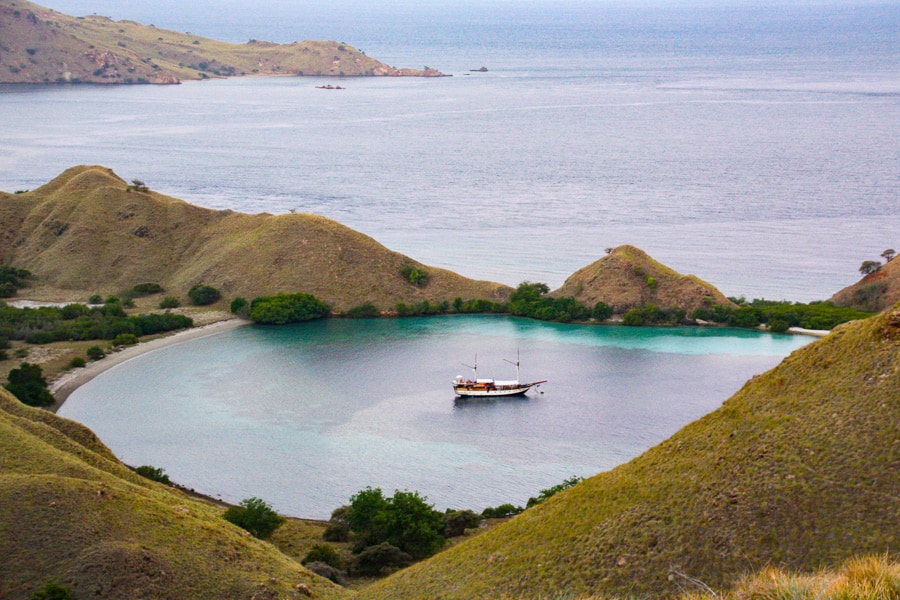
Diving Komodo
Waking up to a spectacular dawn in a quiet corner of Komodo National Park is one of those travel memories that stays with you.
And those sweet moments – standing on deck, the boat gently rocking, looking out over a secluded bay, anticipating the dive to come – are where liveaboards really come into their own.
Every one of our 15 dives on our 5 day/4 night Komodo diving trip was incredible: pristine reefs full of fish life, swimming with majestic manta rays, chilling out with turtles, shark spotting, flying through coral gardens on adrenaline-filled drift dives. It ranks as one of our all-time fave dive destinations.
Check out our post on diving with mantas in Komodo National Park for a taste of what to expect.
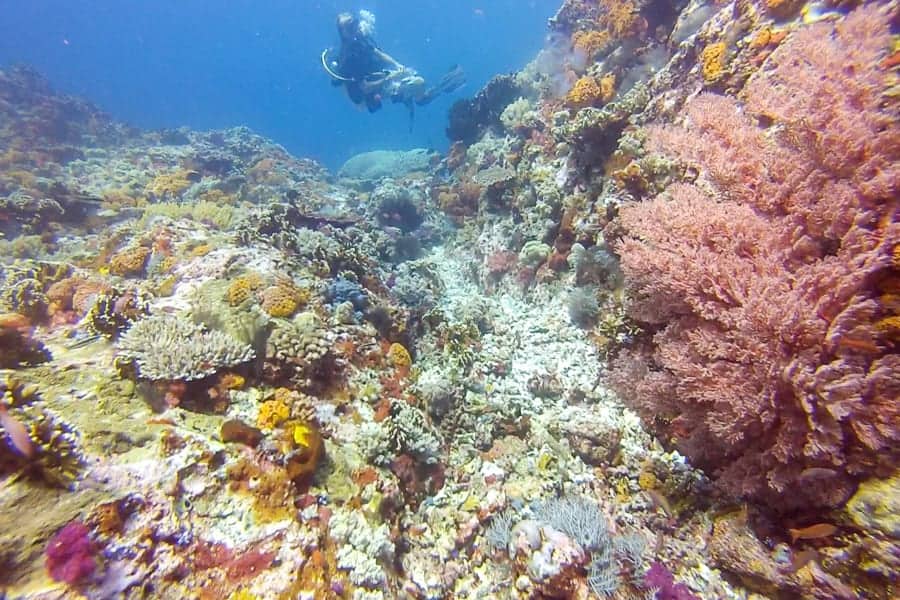
Choose the right snorkel or dive operator
Despite covering around 1,800 kilometres, the fragile archipelago of 26 islands that make up Komodo National Park continue to face pressure from tourism as authorities try to strike the right balance between economic and environmental outcomes.
It’s worth seeking out companies that are members of the Dive Operators Community Komodo (DOCK) group. These are local operators that promote sustainable tourism and conservation programs aimed at protecting Komodo National Park for future generations.
Komodo Dragons
Seeing these fearsome prehistoric lizards up close was a bucket list item for us for years, so we were more than a little bit excited when our liveaboard docked just off Rinca Island for a guided walking safari.
Growing up to 3 metres in length, and with large adults weighing in at around 150kg, visitors are well advised to be cautious around these Jurassic-looking beasties. Not only do they have an incredible sense of smell, they also have venomous glands in their lower jaw, meaning their bite packs quite a punch. And don’t be fooled by their slow, waddling gait: as an ambush predator they can run around 20km an hour when they need to.
Fortunately for us, on the day we visited the dragons were more interested in the cooking smells coming from the rangers’ hut than us. Still, we were grateful for our experienced guides and their long, fork-necked staffs as we hiked around the island and watched the lizards going about their dragon-y business.
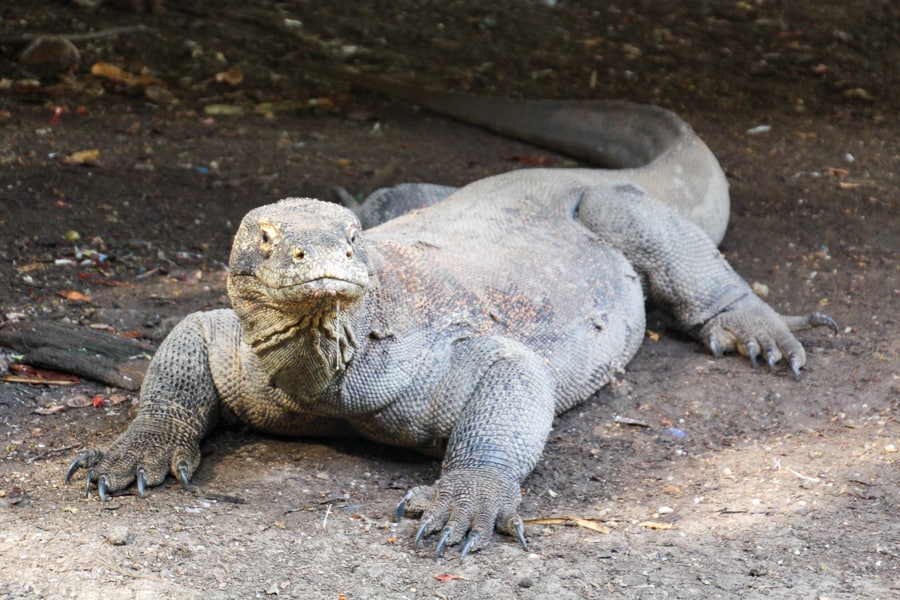
Aussie Dragons?
Interesting fact about Komodo Dragons: Despite the name, fossil records now suggest these primordial creatures were probably roaming the eastern region of Australia around four million years ago and migrated into Indonesia.
WEEK 2: Flores Road Trip
While many people come to Flores to see the dragons and dive, the main island also offers a wealth of natural and cultural highlights. We spent the second week of our itinerary road tripping Flores. You could definitely stay for longer though and explore more extensively.
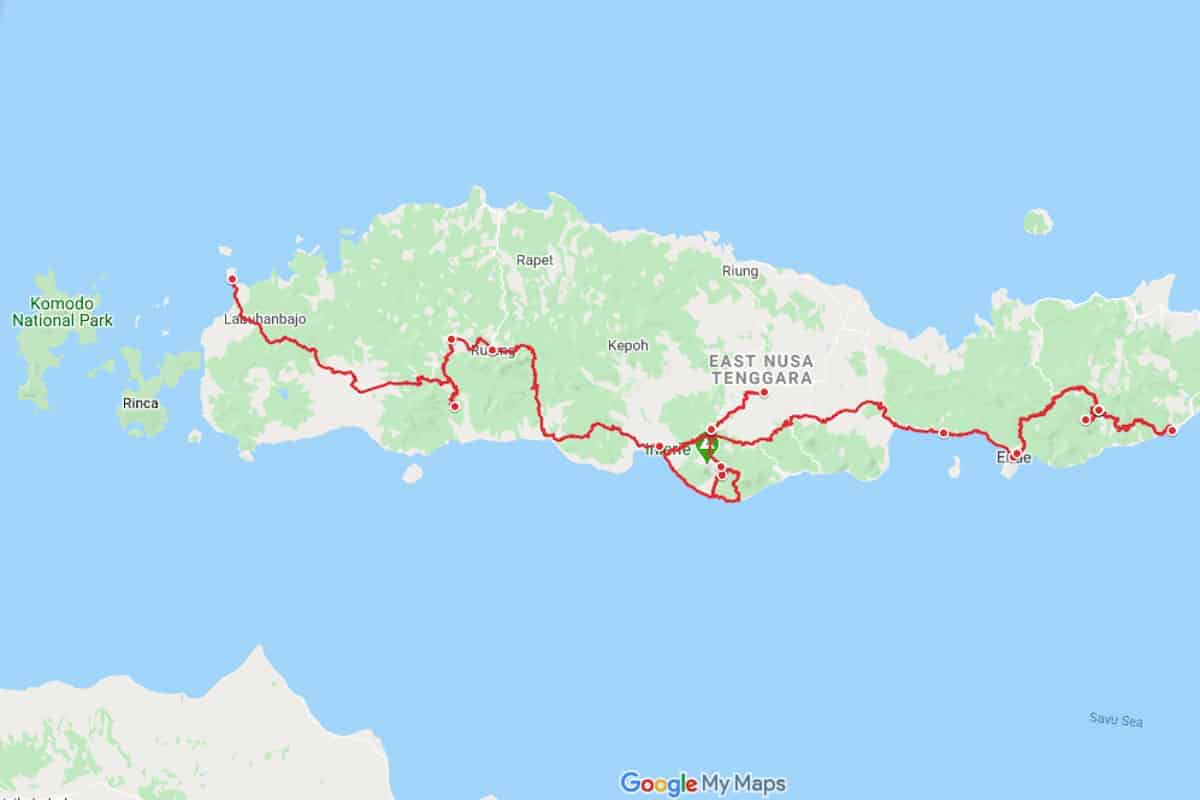
Day 8: Labuan Bajo to Ruteng
Overnight in Ruteng
After finishing up our liveaboard, we spend another night in Labuan Bajo ahead of our road trip, which starts on Day 8.
It’s not until you drive out of Labuan Bajo that you really start to appreciate what all the fuss is about when it comes to Flores. It wasn’t long into the 130km drive to Ruteng, as we weaved our way upwards into the lush highland interior, that we started asking our driver Sipri to pull over for photo stops.
You’ll need to allow at least four hours for the drive to Ruteng, plus some additional time to see the main highlights along the way. These include:
Todo Traditional Village
Flores is dotted with the traditional villages of the island’s diverse ethnic groups; and the opportunity to visit the villages and meet with locals to learn about the customs, beliefs and practices of the different communities is a highlight of a Flores road trip.
Todo Traditional Village is along a fairly narrow, bumpy road not too far off the main road to Ruteng. This is a village of the Manggarai people of western Flores, the largest ethnic group on the island.
The Manggarai are led by the chief of the Todo clan, which makes this small village historically significant as the seat of the royal clan.
The village is dominated by three large Niang Wowang traditional houses, with their distinct conical roofs. During our visit we were treated to a tour of the largest of these houses, with its intricately carved doorway and internal pillars, as well as an impromptu demonstration of a traditional whip fighting ritual known as Caci.
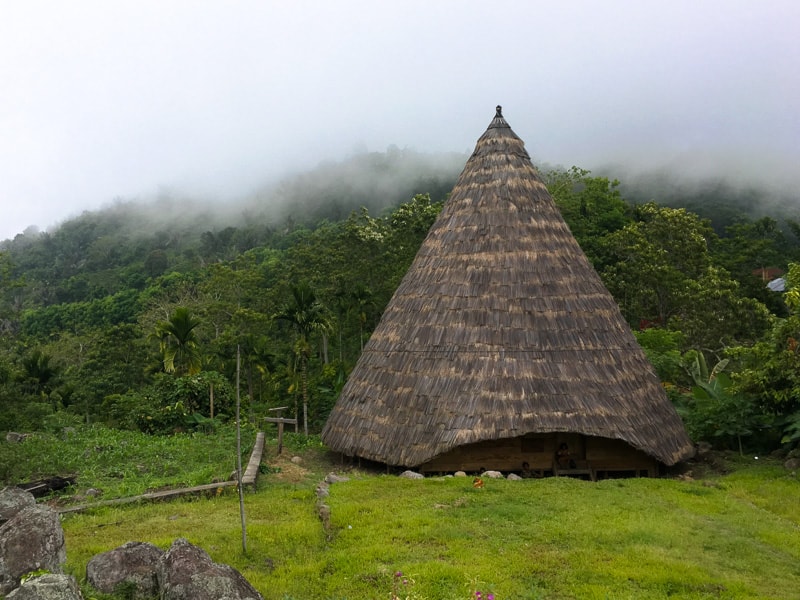
Hiking to a traditional village
If you have more time, it’s worth considering the 3-hour hike to Wae Rebo village. Not only is it larger than Todo village, but staying overnight also provides a great opportunity to appreciate the stunning highland scenery, learn about the Manggarai way of life, and stay in a traditional house. We didn’t get to do the hike on our visit, but it’s definitely on the list for when we return.
Spiderweb Rice Fields
Further towards Ruteng, near the village of Cancar (also sometimes referred to as Cara Village) is a classic example of the spiderweb rice fields the region is known for.
These rice paddies, locally known as lingko fields, are communal fields organised into distinctive segments so they can be farmed by different Manggarai families.
We were able to get great views of the fields by paying a small fee to a local family and taking a short hike to a viewpoint overlooking the fields. Despite the rain, the views were still pretty special and well worth the visit.
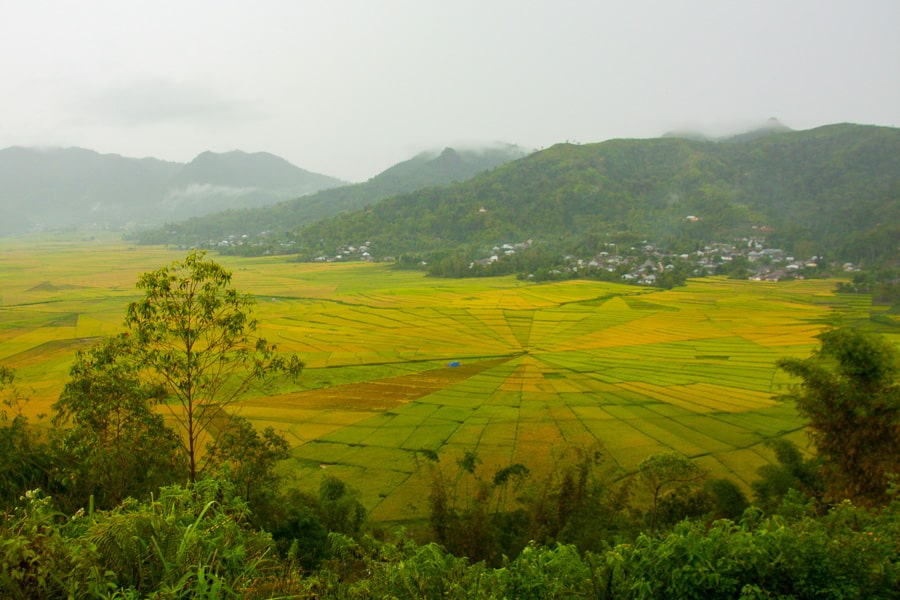
Liang Bua Cave
In a cave around 45 minutes north of Ruteng, a surprise discovery in 2003 shook the scientific community to the core. The fossil remains of a tiny, human-like creature were found. This was ‘Flo’ and, along with the fossilised bones of others of her kind found in the cave, she sparked a debate on human evolution that’s raged ever since.
Flo is Homo floresiensis, a 60,000-year-old species of early human, extinct and distinct from us. The small stature of Flo and her people led to them being nicknamed hobbits and their story is one that is still unfolding.
While the road to the cave is rough, Liang Bua can be visited, and there’s a small, basic museum where the skeletal remains of Homo floresiensis continue to intrigue.
Ruteng
Ruteng is the capital of the Manggarai Regency. It’s a small town with a couple of highlights, including Ruteng Cathedral and Pu’u Traditional Village.
We rolled into Ruteng around mid-afternoon and checked into our accommodation before heading out for a coffee break at Kopi Mane Inspiration. Don’t miss it, their locally sourced coffee is excellent.
We also recommend Agape Restaurant, where we enjoyed a tasty dinner before calling it a day. We were shattered, sure, but we also had a curfew to meet.
Where to Stay in Ruteng
Ruteng feels like a rather sleepy town with a fairly limited range of modest accommodation options available. The following places seem to get consistently good reviews:
- Sun Rice Homestay – clean comfortable rooms | friendly hosts | dinner available | 6km from Ruteng
- Mama’s Homestay – hospitable | comfortable rooms | friendly helpful hosts | close to town
- Sindha Hotel – central | large clean rooms | ensuite bathrooms
We booked a room attached to the local convent run by friendly nuns. Previously called Hotel Susteran, it now seems to be called Hotel MBC Ruteng. Our basic room was clean and quiet (except for our bed, which creaked so loudly we both lay awake for an age trying not to move, lest the nuns get the wrong idea). There’s a 10pm curfew too, but you aren’t likely to be out partying late in sleepy Ruteng.
Day 9: Ruteng to Bajawa
Overnight: Bajawa
It’s another 130km, 4+ hour journey from Ruteng to Bajawa; a drive down from Manggarai country, past bamboo plantations, and along the turquoise coast, before heading back into the cool volcanic mountainscape of the Ngada people.
As you’re serenaded by the smell of drying cloves on the road through the forested mountainside, it’s impossible not to be awed by the abundance of Flores. Coconut, bamboo, candlenut, cloves, coffee and cocoa are plentiful here, alongside maize, rice, sweet potato and cassava.
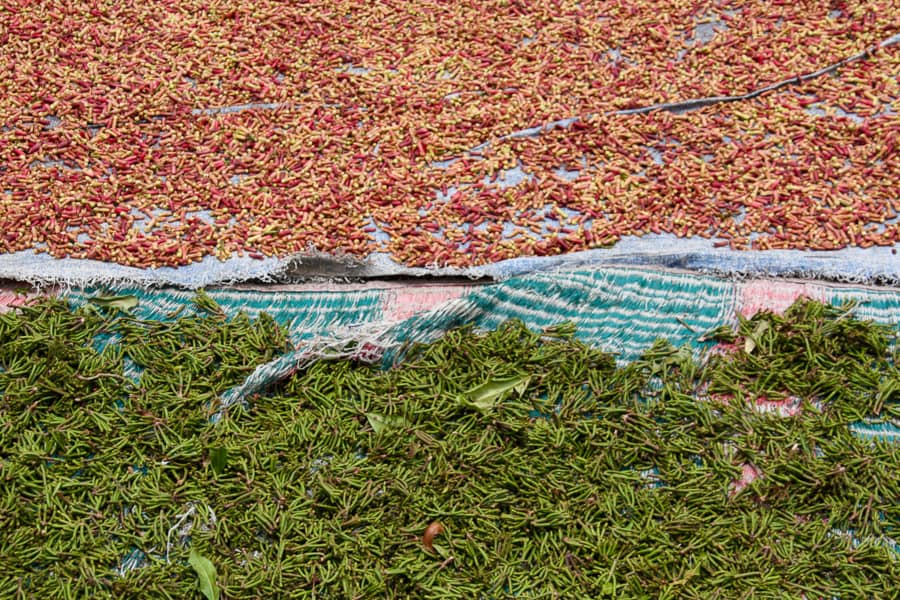
Visiting an Arak Distillery in Aimere
On the way to Bajawa, you’ll briefly skirt the coastline near the small town of Aimere before climbing back up into the hills. Approaching the town, our driver Sipri told us this is his favourite place in Flores to buy arak, and asked if we wanted to visit a local distillery to see how it was made.
Distilled from lontar palm juice, arak is an important local drink for both social and cultural reasons, often used in rituals and ceremonies. While I won’t pretend to completely understand the distilling process using bamboo pipes and a succession of drips, the results were surprisingly good. Even better mixed with pineapple juice, as we discovered back at our hotel. We also discovered just how powerful it is: go sparingly with the pours.
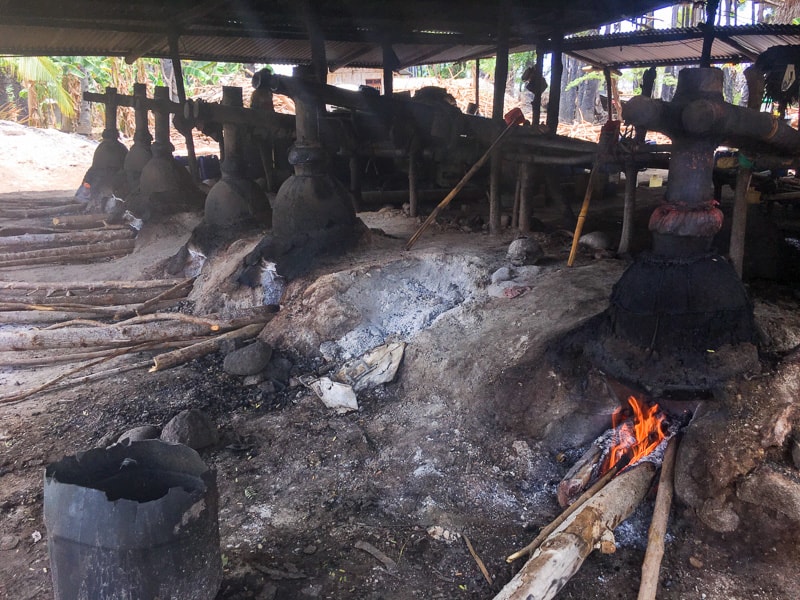
Not all Arak is Made Equal
While we very much enjoyed the arak we tried in Aimere, it would be remiss of us not to highlight that there have been a number of reports, particularly in Bali, of dodgy arak causing vision impairment, blindness, and even death.
We were aware of such reports while visiting Flores and would say to anyone that if you aren’t sure, it’s always best to err on the side of caution and not take any risks. In our case, we felt comfortable taking our driver’s recommendation as a Flores local and customer of this particular distillery.
Mangeruda Hot Spring
There’s nothing better at the end of a busy travel day than a nice, long hot soak in a thermal spring. Fortunately for us, the vulcanology of Flores means there are a number of natural hot springs around Bajawa. So, after checking into our hotel and dropping off our bags, we went out in search of one.
We found our thermal nirvana just 23km northeast of Bajawa in the town of Soa, home to Mangeruda Hot Spring.
While we hear the place gets fairly busy at weekends, we were pleasantly surprised to find our late afternoon weekday visit meant we pretty much had the run of the place.
It’s worth spending an hour or more here, soaking up the ambience of the forest and the varying temps of the thermal waters, which are said to have healing properties.
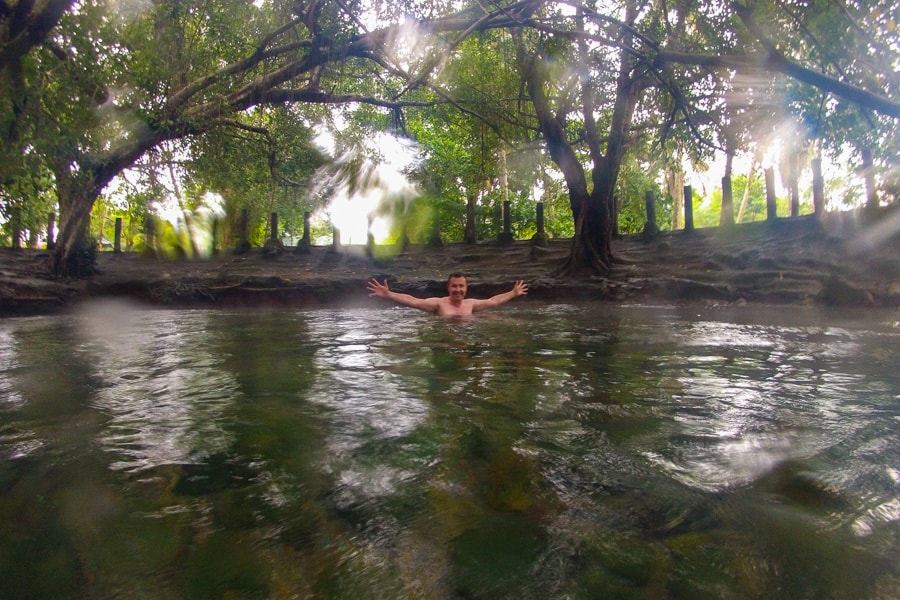
Bajawa
Tucked away in cooler, wetter highlands, Bajawa is the capital of the Ngada Regency. Our time here was accompanied by a persistent, curling mist and a nightly chill factor that had us digging for the fleece.
There are a couple of restaurants scattered around Bajawa, but we ended up returning several times to Lucas Restaurant – a colourful joint with great food and lovely staff. It’s on the second floor of a wooden building on the main street.
Where to Stay in Bajawa
We stayed at the lovely little Hotel Happy Happy in Bajawa. It was clean, basic and located a short walk from the main street and restaurants.
Other options that get consistently good reviews in Bajawa include:
- Bajawa-Roo Hotel – Spacious rooms | great breakfast | rooms with balcony | friendly staff
- Marselino Bacpacker’s Room – delicious breakfast | friendly host | close to centre | simple clean room
- Manulalu B&B – fabulous views | nice bar | comfy rooms | a little out of town
Day 10: Bajawa and the Surrounds
Overnight: Bajawa
With plenty to see around Bajawa, we opted to spend another day here and explore more of the local highlights.
Marvel at Mount Inierie
As you travel around this region, you can’t miss the vast pyramidal wonder of Mount Inierie, Flores’ highest volcano at 2,245m.
Inierie can be hiked, but it’s essential to do so with a guide. By all accounts, including Sipri’s, this is a seriously strenuous climb of 3-4 thigh-burning hours followed by an ankle-rolling descent taking around the same. The views, however, more than make up for it. We were happy to live vicariously on this one, but if you want to add it your itinerary, set aside an extra day.
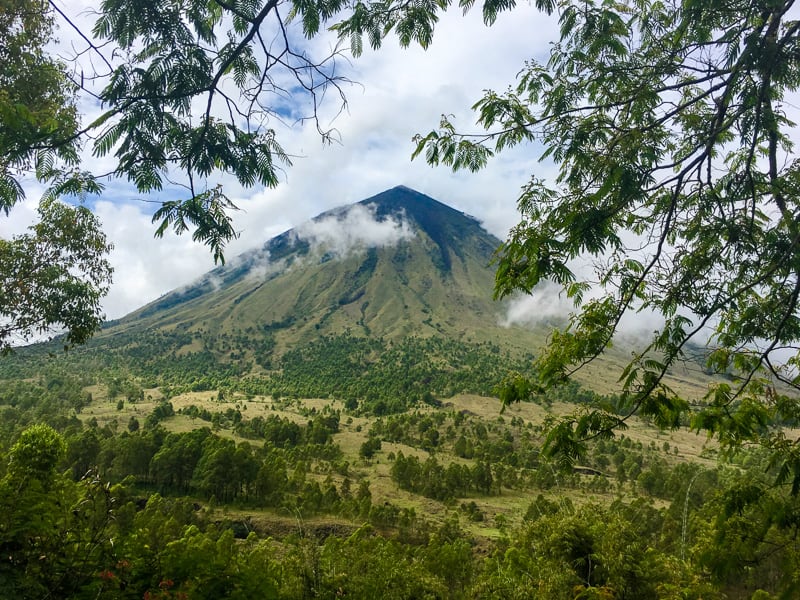
Hike to Wawo Muda
A shorter, easier hike goes to the coloured crater lakes of Wawo Muda, which were created when Flores’ youngest volcano violently announced its arrival just 20 years ago.
A trail winds from Ngoranale village to the lakes, taking around an hour. We’ve read the lakes can disappear in the dry season so it’s better to head up during the wet season, if the weather allows. The views are apparently amazing any time though.
We initially planned to do the hike but as Dan wasn’t feeling great on the morning of, we spent the day exploring the nearby traditional villages instead. You could also opt do a morning hike and see a village or two in the afternoon.
Gurusina and Bena Traditional Villages
Gurusina and Bena are ancestral villages of the Ngada people of the Bajawa region.
Both villages are beautifully sited, with lush mountain backdrops. Thatched huts with peaked roofs skirt large open courtyards. On the day we visited, mats of coconut wedges and cloves were drying in the sun.
In both villages, the forums centre on extraordinary megalithic altars made up of jagged stone shards, where the villagers commune with their ancestors and practice their unique blend of Catholicism and animism.
At Gurusina, we watched as an ancient auntie deftly weaved an ikat (an Indonesian fabric) on a traditional loom at her hut porch. We bought one of her beautiful textiles as a souvenir.
Sipri accompanied us around each village, explaining the traditions and way of life, and translating for us with the villagers.
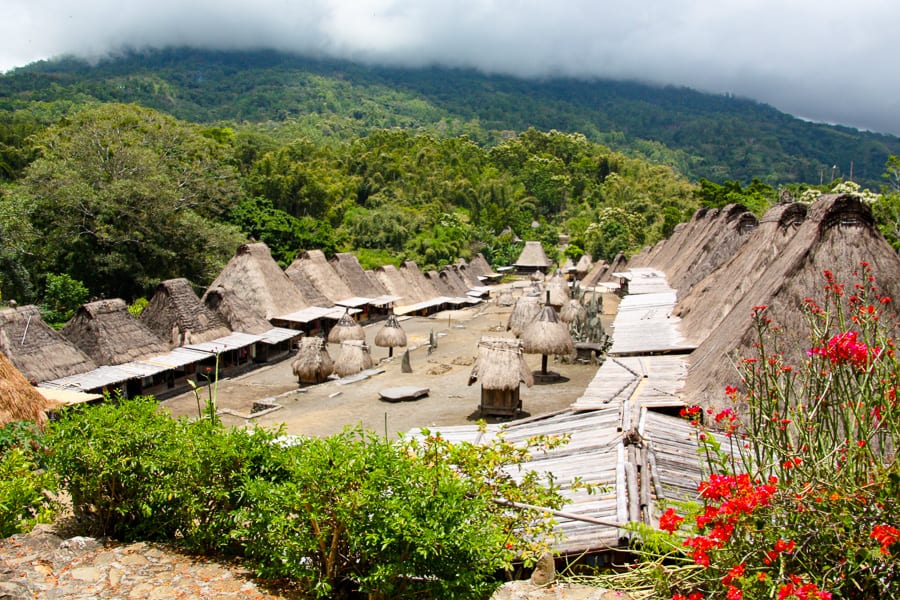
Village Donations: When you visit the island’s traditional villages, have a stash of small money: it’s custom to make a donation when you visit. This is usually made to a village elder or when signing in to the village guest book.
Ask your guide what is fair and appropriate. We usually paid around IDR 10-20,000 each but it can be more at villages like Bena, which has ticketed entry, and Todo, where we were taken on a full guided experience with a village elder.
Bajawa Market
You’ll see local markets throughout your Flores road trip, but the big food market at Bajawa is a standout. It’s a riot of colour and diversity, and a real insight into the amazing breadth of produce farmed on Flores.
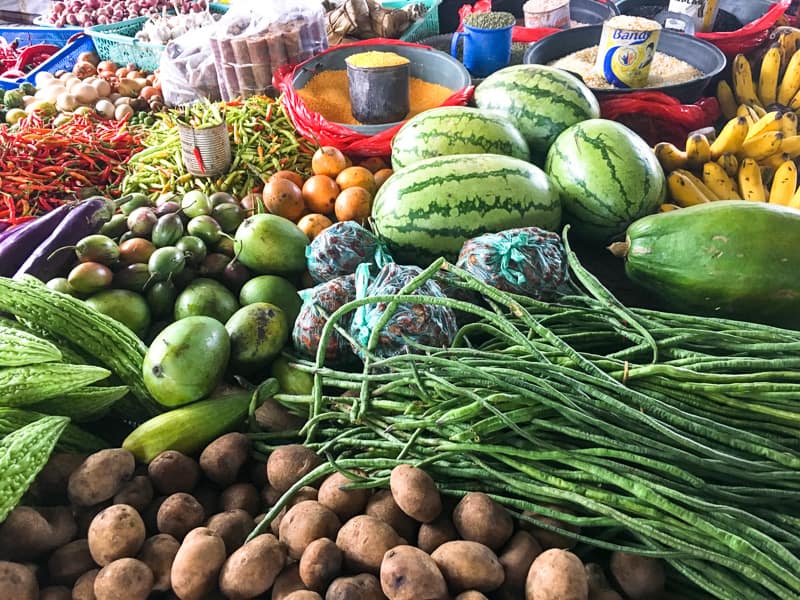
Day 11: Bajawa to Moni
Overnight: Moni
Today’s 5-hour drive takes you on a journey past sky-skimming volcanoes, dramatic jungle highlands, and black sand beaches.
For the first part of the drive, we skirt the brooding Mount Ebulobo, catching tantalising glimpses of the cone volcano soaring more than 2,000m. There are a few viewpoints along the way where you can see the mountain in its still-smoking glory (it last erupted in 1969). Ebulobo can be hiked too if you’re particularly keen – it’s four hours up and four hours down and best done with a guide.
Eventually, the road descends towards the ocean and the coast road to Ende, where another volcano – Mount Iya – dominates the distinctive peninsula.
Blue Stone Beach
The coastal road passes an area known for its unique blue stone beaches. We imagine the sight of these black sand shores covered in pebbles of vivid blue, green, yellow and orange must have once looked quite magnificent.
Sadly, demand for the pretty pebbles as garden decoration has led to the beaches being picked almost bare. On our visit, we saw more of the stones sitting in piles behind the beach than we found on it.
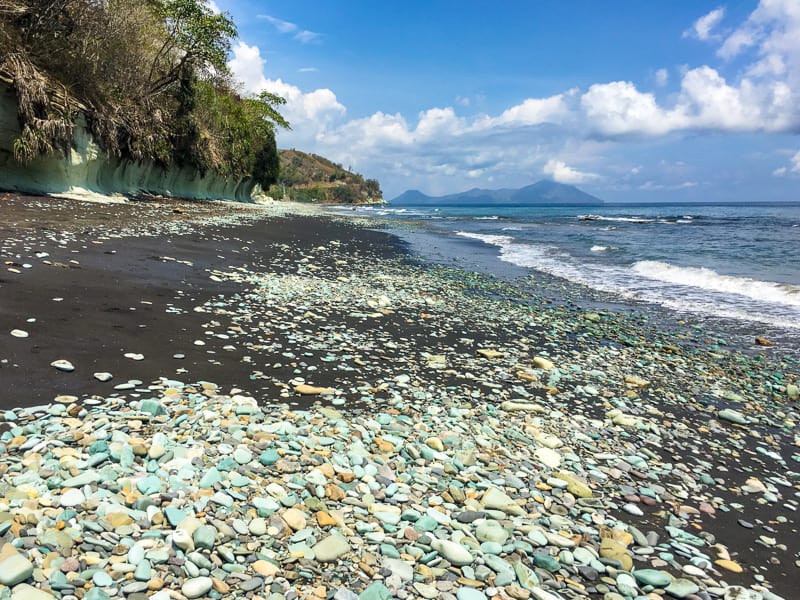
Although a touch disheartened by this discovery on our visit, the striking beauty of this coast and its beaches still left a lasting impression. As did lunch.
Beach Shack Seafood Barbecue
Make 100% sure your itinerary includes lunch at one of the beach shacks in this area. Their simple menus of freshly caught, barbecued seafood with rice, veg and sambal make this a secret nirvana for the hungry traveller.
We had one of the tastiest (and possibly cheapest) seafood lunches we’ve ever had here. Add perfect ocean views and a cool breeze and this moment went down as one of the highlights of our Flores road trip.
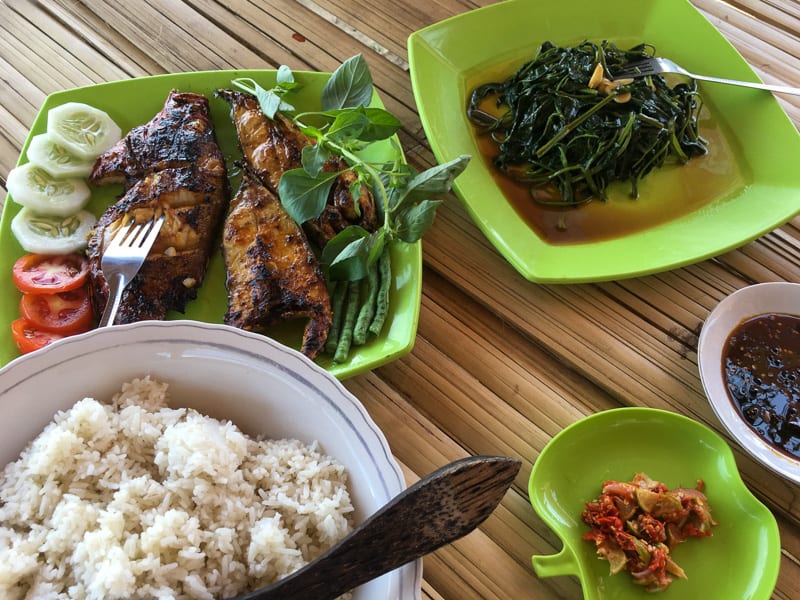
The drive on into the dramatic mountain landscape is a welcome reminder of just how stunning Flores is. It’s well worth stretching your legs near the village of Detusoko to take in the stunning terraced rice fields before finishing your journey in the village of Moni, and a sleep full of anticipation of tomorrow’s dawn prize: Kelimutu.
We spent the rest of the afternoon exploring the gardens at our eco lodge and chilling out in this serene and beautiful environment.
Where to Stay in Moni
We splashed out for the final nights of our Flores itinerary with a stay at Kelimutu Crater Lakes Eco Lodge in Moni. We loved this place. Our room overlooked the idyllic scene of a river running through rice paddies and rainforest. The hotel is committed to conservation and a low carbon footprint. And, being located right at the foot of Kelimutu, getting up for a dawn visit to the crater lakes didn’t feel quite so traumatic.
The following options in or near Moni also get consistently good reviews:
- Rago’s Homestay – basic clean rooms | lovely views | great hosts
- Joseph Guesthouse – large comfy rooms | decent breakfast | nice terrace
- Mahoni Guest House– central Moni | friendly staff | clean basic rooms
Day 12: Around Moni / Kelimutu
Overnight: Moni
It’s a tough ask for any place to live up to three decades of anticipation, so I was feeling some trepidation as we made our way towards the summit of Kelimutu in the dim, pre-dawn light.
The expectation continued to grow during the 20 minute walk from the car park through a swirling, chilly mist to Inspiration Point, where we had our first incredible view of the volcano’s iconic crater lakes.
Staring out across the eerily still lakes as the night slowly lifted was every bit as memorable as my teenage self imagined it would be!
Kelimutu sunrise gets top billing for most Flores tours, so it was busy even when we visited in the off season. It’s worth waiting around after the sun comes up though as many people leave almost immediately.
On the day we visited, the crater lakes ranged in colour from rust and milky blue to a vibrant turquoise. The shades are ever shifting in these beautiful, deadly pools as something chemical called oxidation-reduction takes place. On another trip, we could be treated to red, brown, green, white or even black lakes.
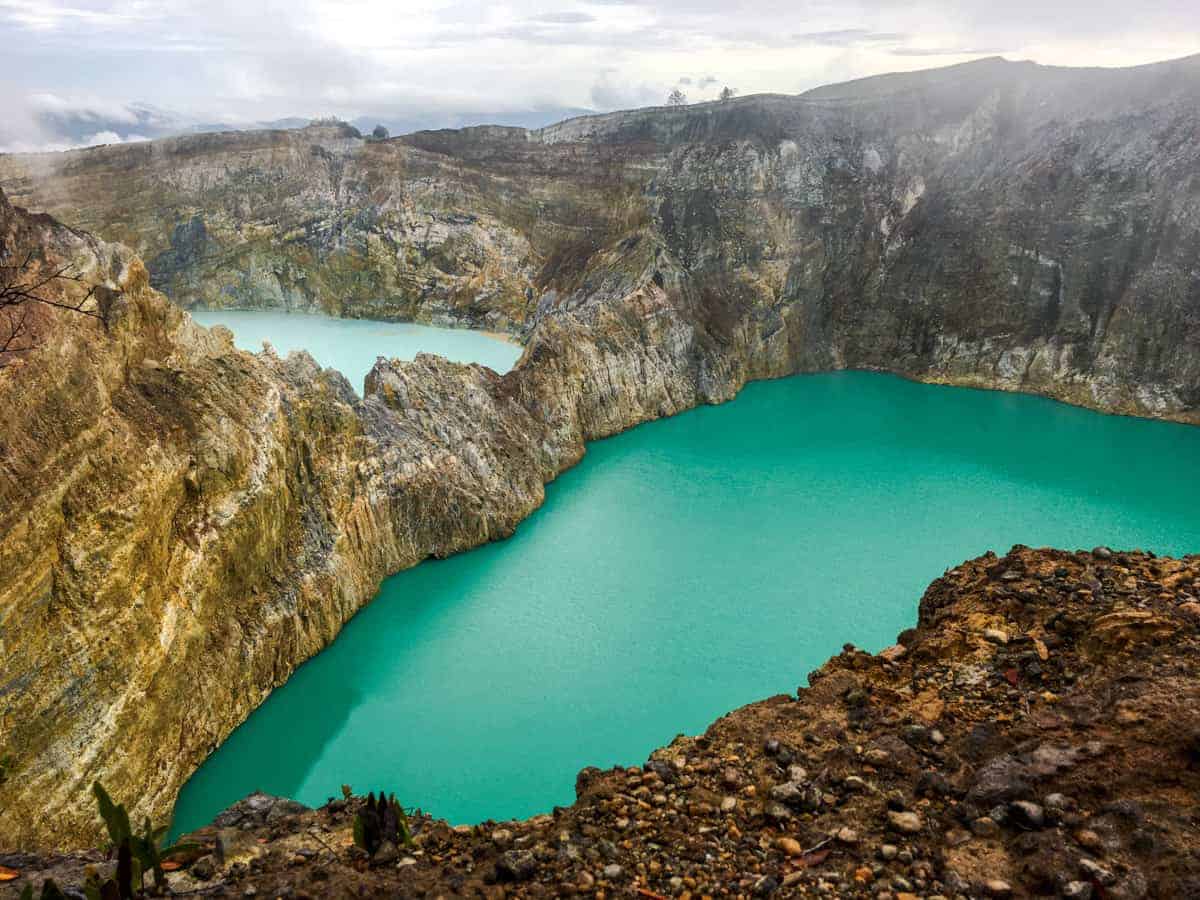
The legend of the lakes
The mountain and its craters are sacred to the local people, who believe souls of the departed reside in the lakes, with one lake for those that die young, one for the aged, and another for evil doers.
Around Moni
The great thing about a 4am start is that you have plenty of time to either take the beautiful track back down the mountain to Moni or, as we did, drive back to your stay for a late breakfast before heading out again for more adventures in the lush volcanic mountainscape.
The picturesque Murukeba waterfall can be reached by a lovely hike through local fields and forest not far from Moni, and this is what we set out for after brekkie.
Afterwards, we visited Djopu village, where we were introduced to the irrepressible Mama Maria, daughter of the chief of the Lio tribe. Mama Maria is a wonderful storyteller and spending some time with her and hearing stories of the tribe’s traditions was another highlight of our Flores trip.
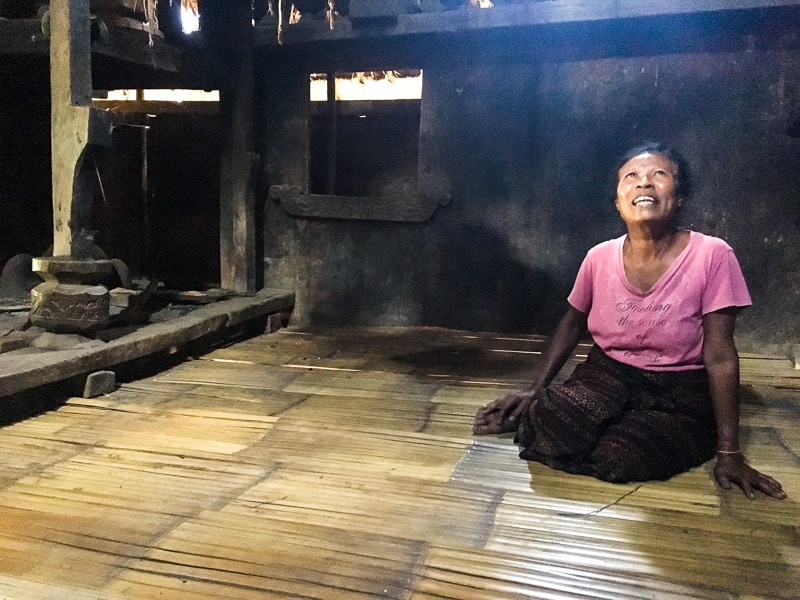
There are a handful of places to eat around Moni. Our faves were Mopi’s Place and Bintang Restaurant.
Day 13: Koka Beach
Overnight: Moni
For many, Kelimutu is the literal peak of their Flores itinerary and their journey ends here, with a flight out of Ende or Maumere airports.
We loved the surrounds though and wanted to stay longer, so we tacked on a third night at the lovely Kelimutu Crater Lakes Eco Lodge.
After a full-on five days of driving and exploring, we welcomed the opportunity for a lazy morning. We slept in, soaked up the views from our front porch, and wandered to Mopi’s for coffee.
Then we hopped back into the car with Sipri and made our way southeast to what may be one of the prettiest secret coves on Earth: Koka Beach.
Koka Beach is properly off the beaten path. It’s about an hour and a half from Moni and Maumere, and down a long and bumpy track off the main road through a large cacao plantation.
Here, two beautiful turquoise bays fan out from a rocky plug of land, like the wings of a bird in flight. Just a handful of other people scattered the gleaming white sand and we happily whiled away the afternoon swimming and chilling. We also enjoyed another outstanding fresh fish lunch at one of the shacks edging the beach.
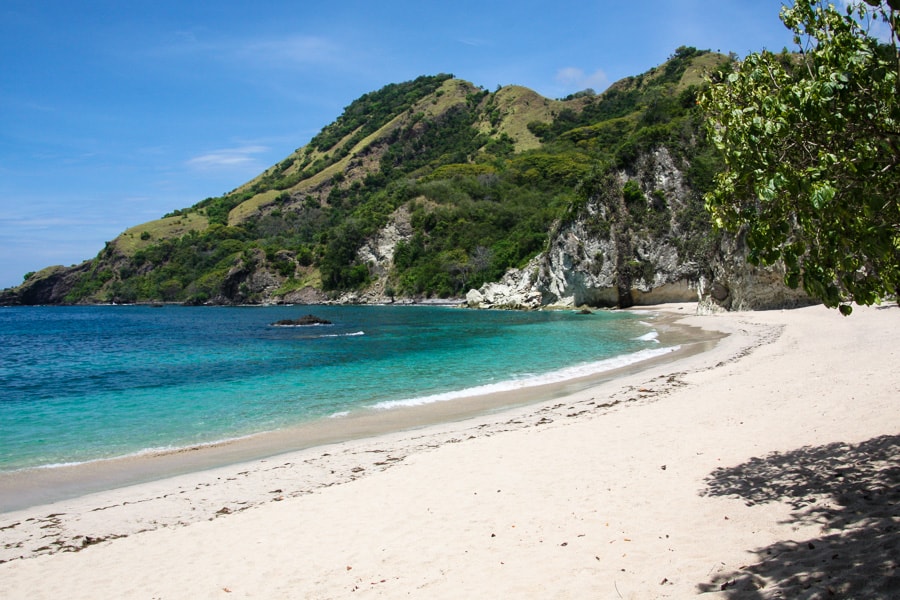
Day 14: Final Morning & Farewell Flores
For us, last days anywhere are always tinged with sadness and at least a thousand declarations of ‘if only we had more time…’.
After a last morning soaking up the gorgeous green scene from our bungalow porch, we packed ourselves into the car for a last drive. Descending from Moni back towards the coast, we were already planning our next visit as we watched the vibrant green Flores landscape slide by.
All too quickly, the hour and a half drive to Ende airport was over and we were saying our farewells to our awesome driver-guide and friend, Sipri.
As it was, we could have squeezed in a bit more time back at Moni. The terminal at Ende airport is tiny and we discovered they don’t actually open the doors until your flight is ready to check in. Avoid waiting outside on the street like we did, and aim to get to the airport when check in opens.
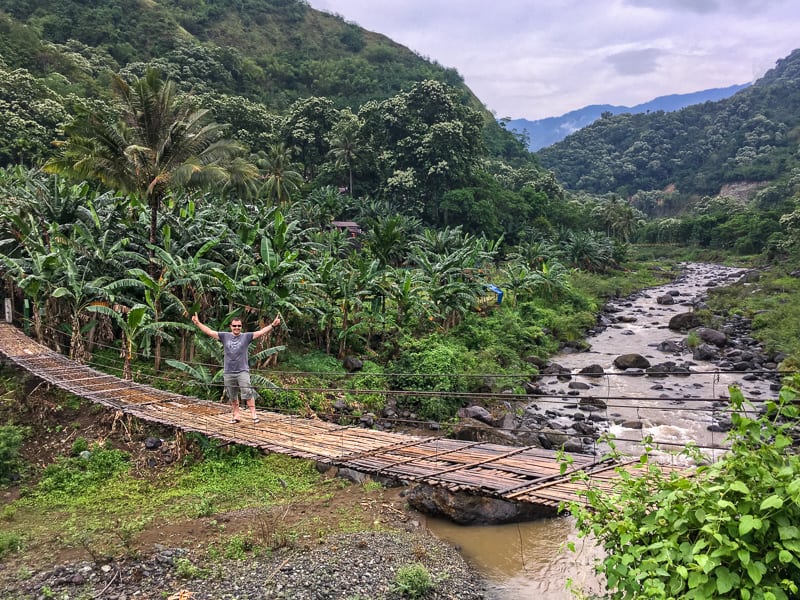
Planning a Flores Trip
For many, a trip to Flores is built entirely around a 2-3 day visit for an encounter with the fabled reptilian residents of Komodo National Park – the giant, prehistoric Komodo Dragon. Fewer people travel beyond the rough and ready edges of Flores’ capital, Labuan Bajo. But there’s so much more!
Time is a key factor in planning a Flores trip. We wanted to ensure we had enough time to road trip the island, visit the dragons on their satellite islands of Komodo and Rinca, and spend some time diving Komodo on the reefs of the national park.
The result was our 2-week Flores itinerary, and that’s the plan we’ve set out below. If you have less time though, or if Komodo diving isn’t on your agenda, you can easily pick and choose from the plan below to build your own itinerary.
If you’re keen for a Flores road trip, we recommend a minimum of 4 days on the main island, plus an extra couple of days to boat trip to the smaller islands of Komodo National Park.
Flores’ mountainous terrain means travel will take longer than you think. We travelled for 7 days and 6 nights and that was in one direction only, without backtracking (we flew into one airport and out of another, see below).
Travel tip: If time is short but Kelimutu Crater Lakes are on your list, consider flying direct to Ende on Flores or taking an internal flight from Labuan Bajo to Ende instead of driving.
How to get to Flores?
Flights to Flores
There are several airports on the island of Flores, however the main hubs are Labuan Bajo in the west, Ende in the centre, and Maumere a little further east. It’s best to book ahead in peak season between July and August.
There are daily flights to and from all of these locations, however the Bali to Flores (Labuan Bajo) route is probably the most popular, with several flights each day. You’ll also find plenty of connections to and from the Indonesian islands of Lombok and Java, including the capital Jakarta, and also Kupang on Timor.
To make the best of our Flores itinerary and avoid any backtracking, we decided to fly into Labuan Bajo with Wings (a subsidiary of Lion Air) from Bali, and then fly back to Bali from Ende with Garuda Indonesia.
Travel By Boat to Flores
Due to the limited time we had, and being well aware of the notorious seas in the region, we didn’t seriously consider travelling to Flores by boat.
However, we understand ferries (including vehicle ferries) are available from various places in Indonesia to Flores, via a range of different routes with varying durations. The main two companies seem to be PELNI and ASDP.
There are also a number of multi-day tourist trips between Bali, Gilis, Lombok and Komodo, however we’d recommend doing some serious research on these options as there are more than a few nightmare stories online about the safety and quality of some trips.
Flores Travel – How Do I Get Around?
The Trans-Flores Highway is the main artery of the island, snaking its way through the volcanic mountainscape between the major centres of Flores. It travels through lush valleys and forests of bamboo, coconut, cashew and candlenut, and along miles of pristine coastline.
The distances may seem relatively short on a map, but travel in Flores can take much longer than expected thanks to the road condition in places, and the steep inclines and winding lanes of the rugged terrain.
Public bus, motorcycle taxis and scooters
You can find travel options to suit all budgets and comfort levels on Flores. Public buses and minibuses ply their trade between the major centres and provide a relatively cheap option for the budget-conscious. Just remember you’ll need to allow extra time for vehicles to fill, and the seemingly endless number of pick-ups and drop-offs along the way.
Private vehicles will also sometimes pick up travellers (for a cost), and we’ve heard that for shorter distances, ojeks (motorcycle taxis) are a good option. As the roads slowly improve, we’ve also heard about people taking their own bikes and scooters to the island, or renting locally.
Hire a local driver-guide
Another great option for exploring the island is to hire a local driver, some of whom also double up as guides. This is a great way to get off the beaten path, meet more local people, and see some of the less accessible highlights of Flores. Due to our fairly limited timeframe, and after some serious research, this is the option we went for, and we’re really glad we did.
We found our driver-guide Sipri while trawling through reviews on TripAdvisor and other forums. A few emails later, we’d agreed on a 7 day/6 night overland Flores tour, departing Labuan Bajo and finishing in Ende.
While it can be a game of chance picking someone on the strength of online reviews, in this case we lucked out. It wasn’t just Sipri’s lifetime knowledge of the very best things to do in Flores that contributed to our awesome journey, it was also that he made us feel totally comfortable with his lovely nature, honesty, flexibility and professionalism.
Flores Weather: When is the Best Time to Visit?
There’s really no bad time to visit Flores and Komodo. Its tropical climate produces fairly consistent temperatures year-round, both above and below the waves.
The best time for a Flores tour, however, is during the dry season, which runs roughly from April to October. The temps are nice, and there’s less humidity, calmer seas and lower rainfall.
Things ramp up between June and August, when the best Flores weather, cool breezes, and crystal-clear waters culminate in the peak tourist season.
From November the heat starts to build, and the hot rainy season takes hold, increasing in intensity as it peaks in January and February. But even then, the occasional heavy shower is worth enduring to enjoy a less crowded, calmer Flores trip.
As always, predicting weather is a fickle business and there are no certainties. Our Flores trip was in the second half of October and we had incredible weather for diving Komodo during our liveaboard trip, and mostly fine weather for our Flores road trip.
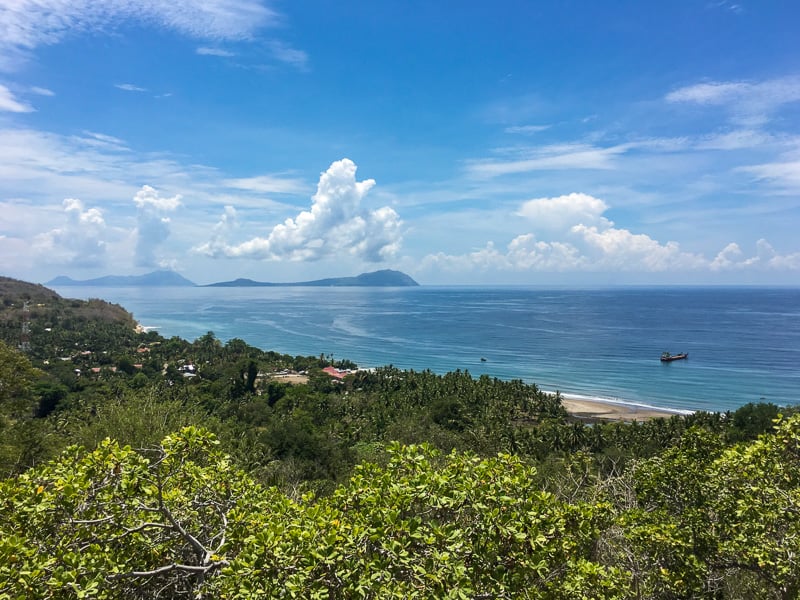
Planning a Flores itinerary? If you’ve got any questions or comments, drop us a message below and, as always, happy travelling!
Check out our Asia page for more travel inspiration for the region.

Hi. We are going next year hopefully with a 3 year old
We want to see as much as possible. We would like to stay on one place longer but reading what you’ve said looks better to move around. Did you book your own hotels as some I’ve seen are too basic offered by tours. I have lots of questions sorry
Hi there Kayleigh,
I think the main challenge with Flores is that roads can be narrow and winding, making travel times quite slow.
I’m sure it would be possible to base yourself in a couple of places where you are able to find accommodation at the standard you’re looking for.
You could then do day trips to explore the island, and while you might not see absolutely everything, I’m sure you could see many highlights.
We found the standard of accommodation varies quite a bit, with small guesthouses and homestays being more prevalent in the smaller towns and villages.
We booked all our accommodation through Booking.com.
Hope this helps, kind regards,
John and Danielle
Hi,
Love all your info on Flores, could I get some info on your live aboard boat from Laban Bajo
We are heading there in Oct
Many thanks
Melissa & David
Hi there Melissa and David,
Thanks so much for your comment, we’re really glad you found the post helpful.
We’ve sent you an email with some additional info and hope you have a fabulous trip in October.
Regards
John and Danielle
Hi John,
Your post is really helpful thank you – we are planning to replicate your itinerary in June/July this year with our 11 year old son.
Can you please provide details of your recommended live-aboard boat trip provider? Is this a private hire, or do we need to share with others? We’d like to be able to mainly snorkel (as our son does not have his PADI licence yet) but would be ideal to have options for snorkeling and diving.
Hi there Liz,
Thanks so much for your comment.
We’ve sent you an email with some additional info.
Regards
John and Danielle
Hi guys, what a great blog and source of information!
I’m planning a Bali – Flores trip for next May-June, with roughly a week in Flores, and I would be grateful if you could share Sipri’s contact with me please.
Thanks!
Hi there Kasia,
Really glad you found this post helpful.
You can find Sipri’s contact details on his website here.
Hope you have a fabulous trip.
The best post on Flores Ive read – way better than any guide book. Thanks!
Thanks Karen, that’s very kind of you to say so.
Thanks Dan, great article!
Would you mind sharing the contact of the liveaboard you went with? If you had a positive experience.
We are family and looking for something cheaper, but clean and with not too many people.
Thanks a lot,
Franz
Hi there Franz,
Have sent you an email with additional info.
Regards
John
Happy to find this super post. I’m flying to Flores-komodo August/September and I world be interest in having some tips on liveaboard as well …
Thanks for sharing
Emanuela
Hi there Emanuela,
Thanks so much for your comment.
We’ve sent you an email with some additional info and hope you have a fabulous trip in Aug/Sept.
Regards
John and Danielle
The road trip looks great! And great information. Please send me the email contact for Sipri as I will definitely need an English speaking driver.
Hi there Larry,
Have sent you an email with additional info.
Regards
John
Hello, loved your write up on Flores! Currently planning our own trip for next month. I wanted to ask, how much experience with diving did you have before doing your komodo liveaboard? I’m planning to get open water certified in Tulamben a few weeks before travelling to Flores, with the hopes of also squeezing in a handful of dives elsewhere to gain experience in case we can do a liveaboard. However I’ve heard it’s hard to enjoy diving in Komodo if you’re not very experienced as it can be quite technical. What’s your opinion on this?
Also, would you mind emailing me the liveaboard company you booked with please?
Thank you!
Lottie
Hi Lottie
Thanks for your kind comments about this post.
We absolutely loved diving in Komodo, but it is worth bearing in mind that diving here can be challenging, especially in terms of getting used to drift diving and strong currents. Being reasonably fit certainly helps when you need to kick a bit harder on occasion.
We were open water advanced qualified when we visited Komodo with around a hundred dives each under our belt.
I would hope reputable operators will always ensure dive sites and conditions are suitable and appropriate for your experience level. For this reason I would strongly advise discussing your level of experience with your chosen dive operator as part of planning your trip.
Have sent you a seperate email with more details on the company we dived with.
Regards
John
Thank you, that’s great advice. I think I’ll possibly reconsider diving in Komodo this year and wait until I have more experience! Take care!
Thanks guys for such wonderful, informative post on Flores. I’m heading late October for 15 days and was planning to do a loop trip but it might not be advisable, as per your post…?
Would you kindly forward me Sipri`s contact and also the liveaboard company that you used? That would be very appreciated.
Thank you, so much
Regards
Julio
Hi there Julio
Have sent you an email with additional info.
Regards
John
Hi John,
This is an amazing blog, very helpful to organize my own trip this coming September.
I would like to ask you Sipri’s contact as well as the liveaboard company you used?
Is it possible?
Thank you very much!
Berta
Hi there Berta,
Thanks for the kind comment about this post.
Have sent you an email with the additional info you’re after.
Regards
John
Hi Guys,
Thanks for your wonderful post on Flores.
I’m planning on doing something similar to what you’ve done and I was wondering what time of year you traveled. Was it October? That may be when I go but was wondering about the weather in general in Indonesia. I am hoping to combine Sulawesi with Flores.
The other question was I have is regarding the liveaboard experience. How did you choose the boat and do you think a few days would be good even though I don’t scuba? I prefer swimming and kayaking, so was wondering if a land based few days might be better. Thoughts?
Thanks again and happy travels
Cheryl
USA
Hi Cheryl
Thanks so much for your message, we’re pleased you’ve found our post on beautiful Flores helpful. We travelled in the second half of October and while that’s the end of the dry season, we lucked out with great weather on the liveaboard and pretty decent weather during our road trip – mostly sunny with the occasional wet day (mainly in the mountains). We’ve included a bit of a write up on best time to travel in Flores the post, but in essence, dry season is best (roughly Apr/May to Sep/Oct). Broadly speaking, the same goes for all of Indo, but it’s worth noting that as the islands stretch over such a distance, weather patterns vary depending where you go.
We chose our liveaboard purely around our diving requirements and found it through researching scuba diving sites and forums. If you’re keen on swimming, snorkelling and kayaking, land-based might give you more options though a quick search online shows lots of day trips and multi-day boat trips out of Labuan Bajo catering for those activities so you’re bound to find something!
We hope you have a fantastic time in Indo!
Cheers,
Danielle and John
Thank you Dan and apologies for the late reply as I’m only seeing your message 6 months later!!
I am planning to go this October and so working on the Flores itinerary now. I’ve booked a week in November in Raja Ampat, but nothing else so far.
Any thoughts on where you’d start your journey after a long slog from NY to Singapore? Somewhere to just recover for a few days. Bali is easiest, but not sure if it’s just too touristy and should give it a miss.
Thanks again. I promise to return sooner to your blog this time around.
Cheryl
Hi again Cheryl, great to hear that your trip to Indo is coming up later this year! If you’re planning to visit Bali anyway, there are some great, low-key places that are off the tourist trail and if you don’t mind travelling a little further by road once you’re there. We’ve always liked Amed and Tulamben on the east coast – they’re a couple of hours by car from Denpasar and have rocky shores/black volcanic sand beaches (great muck and wreck diving too) but much less touristy than Kuta, Semanyak, Canggu and Ubud. Lombok and Gilli Islands off Bali might also be worth researching. Happy planning!
Hey guys, your blog helped me the most so far. A friend and I have about 6 days for a road trip from Badjo, and we are planning to take a lot from here. If you know of companies we could rent a scooter and drop it off in Ende or Maumere that would be amazing.
We might to a round trip back to Badjo, some tips planning it might be helpful, and the rental company too. Thank you guys!!
Hi Sam, thanks for your message! Wish we could help on the scooters front but we didn’t hire them so can’t really say, though there look to be a number of rental agencies in Bajo and no doubt there are online reviews that can help narrow the choice. If you’re wanting to do a round-trip in 6 days, would suggest picking the highlights from our itinerary as trying to do it all would be a push. If you want to see the Kelimutu lakes, then a one-way might be the best option. All the best for your trip, stay safe on those winding roads, and enjoy gorgeous Flores!
Nice guys! I’m taking a lot of info for my own scooter trip, thank you! 🙂
Hey Emi, thanks for your message! A scooter trip through Flores will be fantastic – travel safe and have a brilliant time! Cheers, Danielle & John